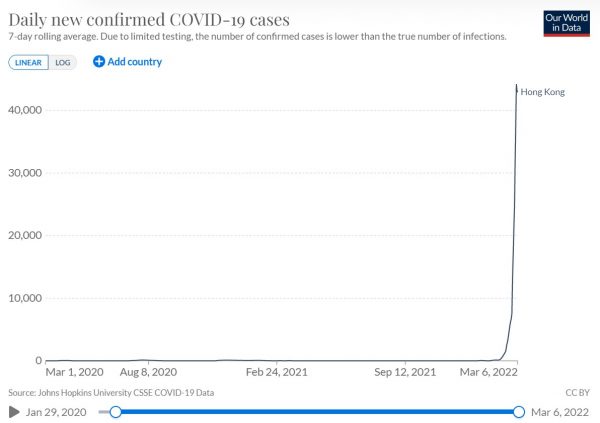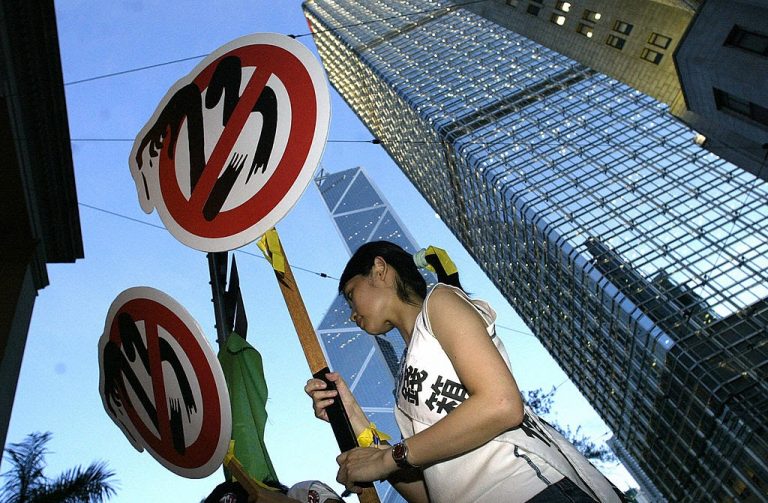While the entire world has its eyes focused on the military conflict between the Russian Federation and an alliance formed by neighboring Ukraine, NATO, and numerous other countries and corporations, in Hong Kong, a pseudo-democracy under the rule of the Chinese Communist Party, Coronavirus Disease 2019 (COVID-19) has taken a shocking change for the worse.
According to March 7 data from aggregator Our World in Data, the city of nearly 7.5 million people has done very well against the pandemic, facing a daily death count of mostly zero and daily confirmed case counts in the single or double digits throughout the absolute majority of the pandemic’s entire course.
That all changed in early February, however, when confirmed cases suddenly spiked into three, and then four digits before registering the first five digit day on Feb. 26 when more than 13,000 new infections were logged.

The same day, Hong Kong logged 43 new deaths.
While this figure appears insignificant compared to many European and North American locales, the city had logged close to zero fatalities in total between November and January.
Success
You are now signed up for our newsletter
Success
Check your email to complete sign up
And March has been even more tumultuous. The first day saw 93 deaths registered, a number which has increased significantly with each passing day, claiming 192 lives on March 6.
Daily new confirmed cases are shaded with a color yet more grim. 24,000 new cases were logged on March 1, increasing steadily to more than 44,000 by March 4.
Based on a cumulative update based on data current to March 7 issued by the city’s Centre for Health Protection (CHP), the first week of March averaged more than 41,500 new cases per day, which more than doubled over the week prior.
Notably, CHP data shows that between 99.5 and 100.0 percent of all new positive tests originate within Hong Kong, as opposed to being imported.
Official March 7 data from the Hong Kong government remarks that more than 8,000 people are currently hospitalized in association with COVID-19, with an additional approximate 2,300 held at the city’s quarantine camp.
RELATED READING:
- Hong Kong Tightens COVID-19 Restrictions, Orders Culling of 2,000 Hamsters Over Exposure to Virus and Arrests For Breaking Quarantine
- Fleeing National Security Law, More Than 20,000 Hongkongers Resettle in Taiwan
- Pillar of Shame: Tiananmen 1989 Mass Murder Memorial Removed From Hong Kong University
But Hong Kong Free Press notes in March 5 writing that the government only tabulates data collected from the city’s public Hospital Authority (HA), noting that “the authority does not provide data in a format that would allow for further analysis on a spreadsheet.”
The outlet noted a daily death count tally discrepancy between the CHP and the HA’s figures, ranging from as low as 7 to as high as 97 between Feb 20 and 28.
HKFP notes that the CHP “is responsible for tallying the number of people who tested positive with the coronavirus but died outside the public healthcare system.”
Lead medical officer of the CHP, Albert Au, told reporters on March 2 that deaths outside of the HA would be included in his organization’s counts, and that although he was unable to provide a firm total, his office would provide the city’s media with a tally in writing.
But it appears Au’s promises have not been fulfilled, “However, his office has not returned HKFP’s repeated requests for data and comment as to why its data has diverged from the HA’s as the fifth wave progressed,” said the Free Press.
Meanwhile, a spokesperson for the HA was paraphrased as telling reporters, “the agency began installing refrigerated containers outside its hospitals to store up to 500 bodies temporarily,” but could also not provide data.
HKFP’s own investigations captured photographs of two large, temperature-controlled shipping container-style units outside of the Queen Elizabeth Hospital mortuary.
Based on March 4 reporting by the Beijing-friendly South China Morning Post, hospitals are running out of oxygen cylinders and having to rely on wall-mounted distribution units, which requires placing patient beds in very close proximity to one another.
One anonymous doctor, also at the Queen Elizabeth Hospital, was paraphrased as saying “About a dozen critically ill patients, admitted earlier in the week, had been stuck in a resuscitation room for periods ranging from 16 to 24 hours before being transferred to other wards.”
One pseudonymous nurse told SCMP some wards were beginning to smell of human waste because crowded conditions had left staff unable to change the diapers and bedpans of elderly and ventilated patients.
A March 2 thread compiled by an unverified Twitter account noted the similarities between Hong Kong and New Zealand’s outbreaks. But it also noted some key differences, such as Hong Kong’s 50 percent larger population and much smaller land area.
But specifically, the pundit noted that although Hong Kong has a high vaccine acceptance rate to begin with, rivaling New Zealand’s, acceptance rates in Hong Kong’s 70-79 and 80+ age demographics were as low as 63.1 and 34.2 percent.
Hong Kong’s figures for this age bracket are a significant outlier. New Zealand, like most other western countries, by comparison boasts a more than 95 percent vaccination take rate in the same age groups.

Although the hypothesis has its merit, the CHP’s data appears to refute the claim, showing the age distribution of the landslide of new positive tests is primarily concentrated in the 20 to 69 age brackets.
Despite the unprecedented rise of cases, deaths, and hospitalizations in the city, the numbers may not be artificially inflated. March 7 reporting by SCMP stated that online self-reporting of rapid antigen tests only launched the same day before quickly crashing due to an immediate overload.
The article summarized the breadth of the online portal’s reach, “Users are asked to provide their personal details as well as those of their household members, their symptoms, living environment and the condition of the others in the home.”
“They will then receive an SMS with a link to upload a photo of their positive rapid test result and identity card. They can then download an isolation order, and health authorities will make arrangements to determine whether they need to be sent to hospital or quarantine facilities.”













